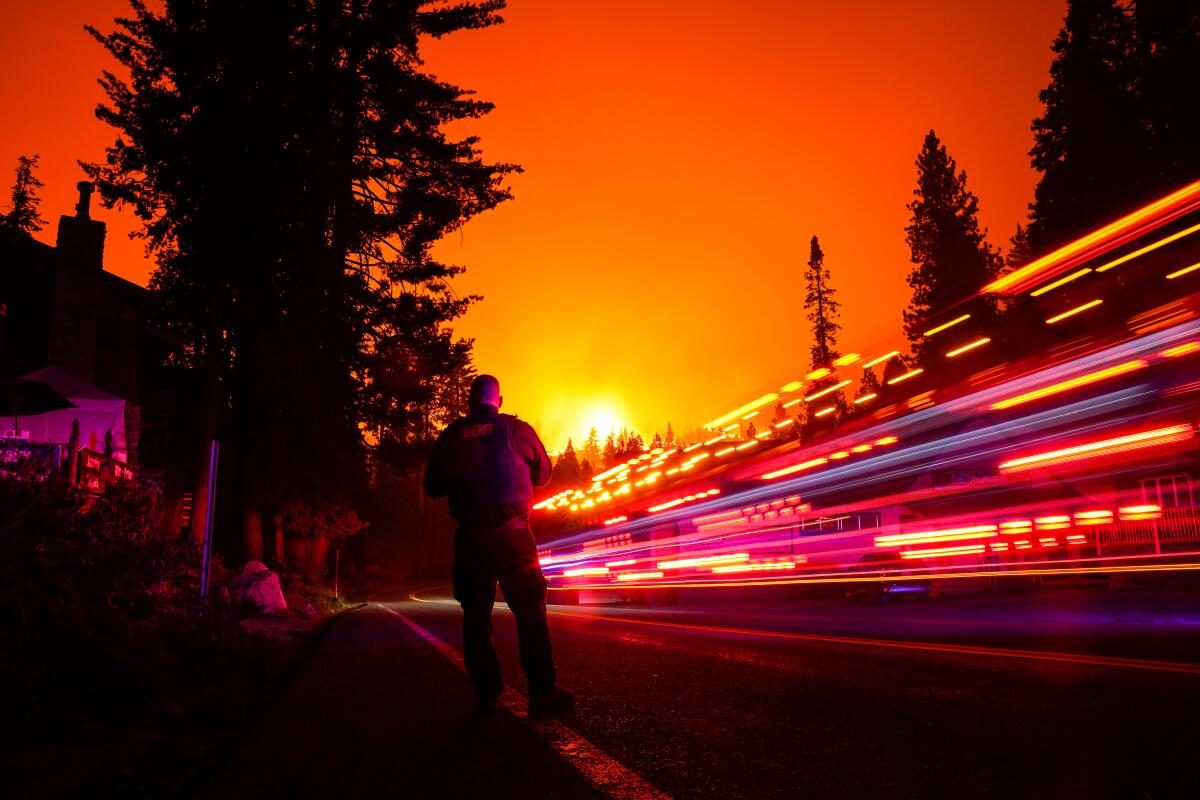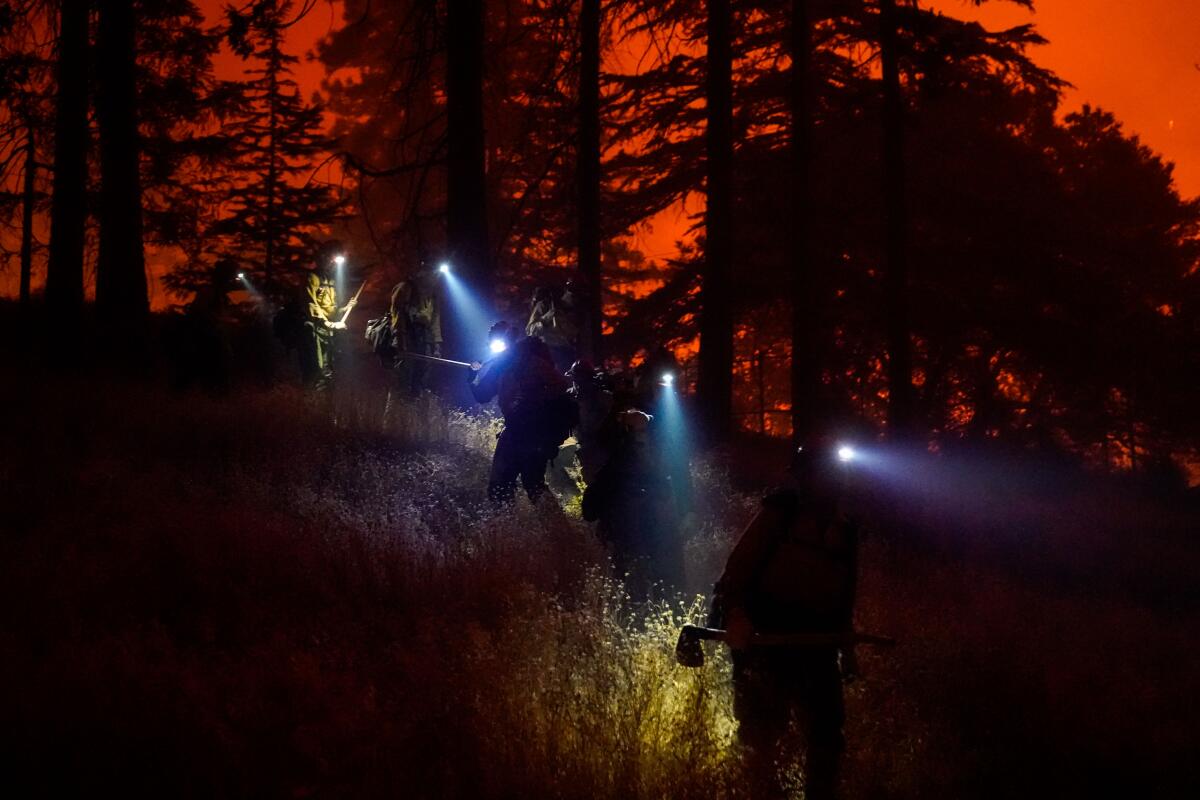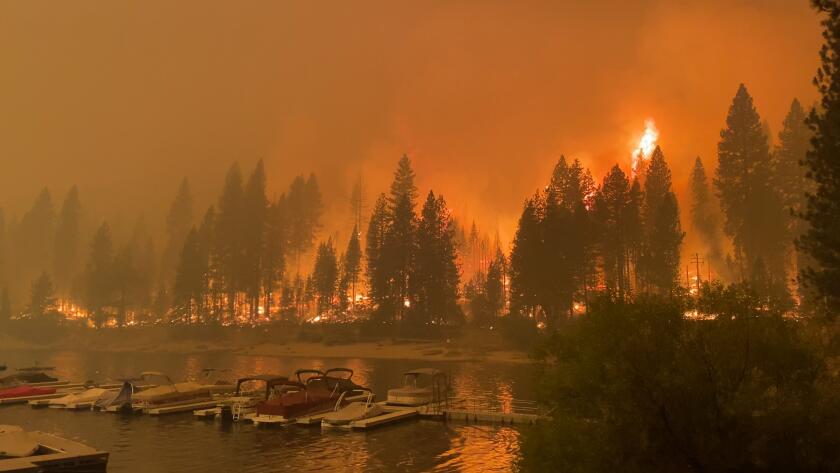Chaos in Sierra town of Big Creek as massive fire destroys many homes
Big Creek, a California town of fewer than 200, was devastated by the Creek fire, which has burned more than 78,000 acres.
BIG CREEK, Calif. — The raging Creek fire, which trapped hundreds of campers and ravaged large parts of the Sierra, is taking a devastating toll on the town of Big Creek, Calif.
Photos from residents and others showed numerous homes destroyed in the Sierra town as the fire burned more than 78,000 acres. Early reports were that at least two dozen dwellings in the town have been lost, but no official assessment had been made Monday amid the burgeoning emergency. Exploding propane tanks have caused further damage, said Christopher Donnelly, chief of the area’s volunteer fire department.
With a population of fewer than 200, Big Creek is a beloved town familiar to many who visit the Sierra.
The fire trapped more than 200 hikers in the Mammoth Pool recreation area when it crossed the San Joaquin River on Saturday afternoon, prompting a massive rescue effort by the California National Guard.

Gov. Gavin Newsom late Sunday declared a state of emergency for the counties affected by the fire.
Monitoring the fire from his home in Fresno on Sunday morning, Duane Ruth-Heffelbower was trying to put together a picture of the last 24 hours, in which the Creek fire had grown to nearly 40,000 acres. Ruth-Heffelbower has been going up to Huntington Lake for 45 years and is executive director of a church camp on the west end of the lake.
Saturday morning evacuations played a key role in allowing strike teams to put together a plan to protect property, and by evening a few backburns were started that have so far kept most of the cabins ringing that portion of the lake safe.
An upgraded water system also played a role, said Donnelly. In a neighboring tract of nearly 40 cabins, five have been lost.
Donnelly was on the north shore of Huntington Lake on Saturday when he heard sirens at 5:30 a.m. Sheriff’s deputies were en route to Big Creek, a small town of about 60 homes just west of and nearly 2,000 feet below Huntington Lake.
The town, most of whose residents are employees of Southern California Edison, which owns and manages the hydroelectric facilities in the area, was being evacuated. Donnelly was in Big Creek by 6 a.m. and saw the fire — with a column of smoke rising nearly 10,000 feet — burning to the south.
By 7:30 a.m., smoke poured through Big Creek, and Donnelly knew it was time to leave. The wind, which during the night blew into the valley, was shifting direction and gaining velocity.
Once the Creek fire reached Big Creek, it would race upslope to Huntington Lake. He recommended to the California Department of Forestry and Fire Protection incident commander that the communities along Huntington Lake be evacuated as well. Fire engines belonging to the volunteer fire department began to drive through the tracts making the announcement to residents and vacationers.
Cell towers and power are down in the region, so tallying the damage will come later.

On the south fork of the San Joaquin River, Mammoth Pool was a getaway for Central Valley residents looking to escape the heat wave, and by some estimates, nearly 1,000 people were camping at the site in advance of the long weekend.
The California Air National Guard on Saturday night airlifted scores trapped by flames at Mammoth Pool.
Two people had suffered life-threatening injuries. They were put in the helicopters first. Then came the 19 “walking wounded,” who needed hospital care but were not considered critical. Crews also prioritized children and those with underlying health conditions, officials said.
Some of those at Mammoth Pool described a terrifying scene of driving through flames and finding shelter wherever they could.
Jeremy Remington told ABC30 that he and his family were boating when they went to fill their chest with ice. In less than 30 minutes, he said, the fire was roaring toward them.
“The fire completely engulfed everything, all around us,” he said, adding that they poured water on their shirts and used them to cover their faces as protection against the smoke and heat.
“We do believe there will be more rescues,” said Col. Dave Hall, commander of the 40th Combat Aviation Brigade, which flew the mission.
“We are posturing crews day and night to support potential rescues. What is unique about the terrain up there is it is a very, very popular camping site and also backpacking site. And because the fire travels very quickly, it is very possible for backpackers and hikers to potentially be stranded.”
More to Read
Sign up for Essential California
The most important California stories and recommendations in your inbox every morning.
You may occasionally receive promotional content from the Los Angeles Times.














